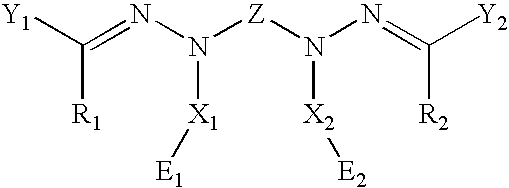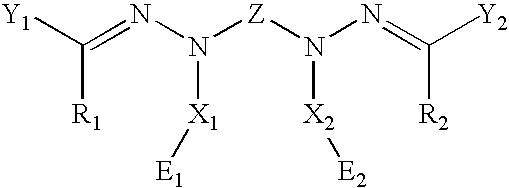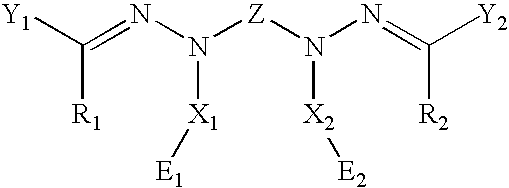Organophotoreceptor with a charge transport material having two epoxidated-hydrazone groups
a charge transport material and organophotoreceptor technology, applied in the field of organophotoreceptors, can solve the problems of affecting the performance of the organophotoreceptor, the additional complication of liquid electrophotography, etc., and achieves good electrostatic properties, high vacc, and high compatibility with the polymer binder
- Summary
- Abstract
- Description
- Claims
- Application Information
AI Technical Summary
Benefits of technology
Problems solved by technology
Method used
Image
Examples
example 1
Synthesis And Characterization Charge Transport Materials
[0107]This example described the synthesis and characterization of Compound (2) in which the numbers refer to formula numbers above. The characterization involves the chemical characterization, and the electronic characterization of materials formed with the compound is described in the subsequent examples.
Compound (2)
[0108]A suspension of 4,4′-dichlorodiphenyl sulfone (20 g, 0.069 mol, obtained from Aldrich) in hydrazine hydrate (158 ml, obtained from Aldrich) was refluxed for 24 hours. The mixture was cooled to room temperature and crystals precipitated out. The crystals were filtered off and washed 3 times with water and one time with isopropanol. The yield of the product, 4,4′-dihydrazinodiphenyl sulfone, was 15.75 g (81.8%). The product had a melting point of 193-194° C. The literature procedure for the preparation of 4,4′-dihydrazinodiphenyl sulfone was published in Khimiya Geterotsiklicheskikh Soedinenii, 11, p. 1508-15...
example 2
Charge Mobility Measurements
[0113]This example describes the measurement of charge mobility for charge transport materials, such as Compound (2) described above.
Sample 1
[0114]A mixture of 0.1 g of Compound (2) and 0.1 g of polycarbonate Z-200 (from Mitsubishi Gas Chemical) was dissolved in 2 ml of tetrahydrofuran. The solution was coated on a polyester film with conductive aluminum layer with a dip roller. After the coating was dried for 1 hour at 80° C., a clear 10 μm thick layer was formed. The hole mobility of the sample was measured. The results are presented in Table 1.
Mobility Measurements
[0115]Each sample was corona charged positively up to a surface potential U and illuminated with 2 ns long nitrogen laser light pulse. The hole mobility p was determined as described in Kalade et al., “Investigation of charge carrier transfer in electrophotographic layers of chalkogenide glasses,” Proceeding IPCS 1994: The Physics and Chemistry of Imaging Systems, Rochester, N.Y., pp. 747-752...
example 3
Ionization Potential Measurements
[0117]This example describes the measurement of the ionization potential for the charge transport materials, such as Compound (2) described in Example 1.
[0118]To perform the ionization potential measurements, a thin layer of charge transport material about 0.5 μm thickness was coated from a solution of 2 mg of charge transport material in 0.2 ml of tetrahydrofuran on a 20 cm2 substrate surface. The substrate was polyester film with an aluminum layer over a methylcellulose sublayer of about 0.4 μm thickness.
[0119]Ionization potential was measured as described in Grigalevicius et al., “3,6-Di(N-diphenylamino)-9-phenylcarbazole and its methyl-substituted derivative as novel hole-transporting amorphous molecular materials,” Synthetic Metals 128 (2002), p. 127-131, incorporated herein by reference. In particular, each sample was illuminated with monochromatic light from the quartz monochromator with a deuterium lamp source. The power of the incident light...
PUM
| Property | Measurement | Unit |
|---|---|---|
| thickness | aaaaa | aaaaa |
| thickness | aaaaa | aaaaa |
| thickness | aaaaa | aaaaa |
Abstract
Description
Claims
Application Information
 Login to View More
Login to View More - R&D
- Intellectual Property
- Life Sciences
- Materials
- Tech Scout
- Unparalleled Data Quality
- Higher Quality Content
- 60% Fewer Hallucinations
Browse by: Latest US Patents, China's latest patents, Technical Efficacy Thesaurus, Application Domain, Technology Topic, Popular Technical Reports.
© 2025 PatSnap. All rights reserved.Legal|Privacy policy|Modern Slavery Act Transparency Statement|Sitemap|About US| Contact US: help@patsnap.com



